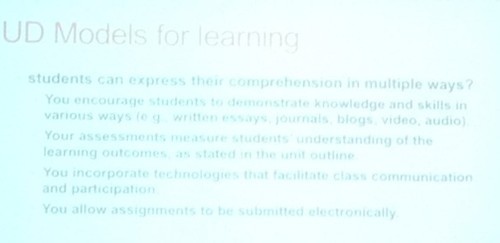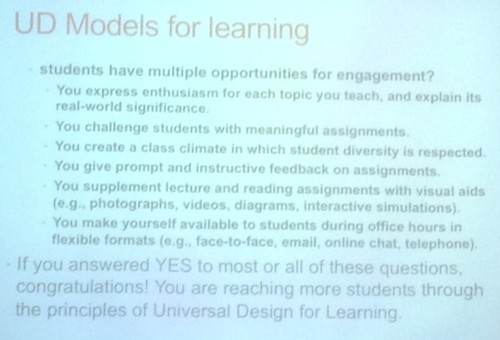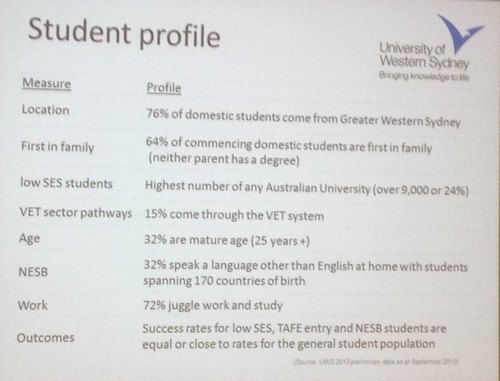Text
Ascilite 2014: Rhetoric vs reality
The theme of the conference was “Rhetoric vs Reality” which really resonated with me.
There was a general feeling of consensus amongst presenters and conference delegates that the rhetoric of Learning and Teaching and the reality of it are two different things. We say one thing and we tend to do another. Of greatest concern was the message that this undermines our credibility with our clients.
http://ascilite2014.otago.ac.nz/proceedings/
Below you will find snapshots of some of the presentations.
0 notes
Text
Master of Education (Knowledge Networks and Digital Innovation)
Judy Connell, Charles Sturt University
· New program based on addressing the digital environmental needs of educators.
· The program includes a thorough evaluation of digital learning ecologies
· Lifelong and life wide learning is a central tenet of the program
· Future educators must be agile and responsive

http://www.iftf.org/futureworkskills/
0 notes
Text
Changing the face of learning @ UWS
Tim Griffin
Institution wide transformation over a 3 year period. From 2015 UWS courses will be online.
· A top down approach was taken and this can be problematic
· school level control and implementation with little interference was one of the keys to success
· Approved BL plans are given workload allocation resourcing to give staff time to implement their plans
· Priority units were identified - stage one priority was given to first year courses
· Embedding learning designers (BLADES) in schools is very important.
· Promotion is connected to BL plans to act as an incentive

0 notes
Text
Carmel McNaught was awesome
Some words of wisdom:
· Make time to keep up by reading. e .g Horizon report
· Don't forget the J curve: Things get worse before they get better
· You can't ask for change without evidence
· Once change does happen, you need follow through for it to continue and become self sustaining. Effective change takes time and monitoring over time is essential.
· L&T research needs to be conducted much more rigorously

0 notes
Text
Universal Design Models for learning
Iain McAlpine
Veryuseful presentation that focussed on promoting awareness and implementation of Universal Design principles for learning. The following 3 slides summarise this very well (apologies for the quality of the shots):



0 notes
Text
OER universities
Wayne Mackintosh
The growth model isnt sustainable and OER’s can help to move to more sustainable practice. OERu http://oeru.org/

OER is sustainable and renewable - how will USC stay sustainable without OER?
Higher education requires openess and exceptions from copyright legislation:
Content created using public funds should be available freely for use by everyone
There should be no restrictions on copying by educators for L&T purposes
Comparing business models…

0 notes
Text
Redesign from f2f to online
Carole Hunter CSU
250 subjects redesigned for online over 2 year period - 198 after revision and rationalisation
Success was based on:
· Defining what quality online means - connected, meaningful, engaging, challenging
· A negotiated design relationship between educational designers and academics
· Acceptance that redesign takes time. Redesign required between 30 to 100 hours
0 notes
Text
Blended Learning @ UWS
Carol Russell
Carol Russell (UWS) makes the point that all students want flexibility. What do students mean by flexibility?
· Availability of both f2f and online learning options
· Ability to study while working or caring for family
· Classes timetabled to suit their time management

Defining blended learning from a student perspective

0 notes
Text
Virtual Worlds
Sue Gregory
Virtual worlds working group. www.vwwg.info
Virtual worlds are used most in education and health discipline areas.
The future of virtual worlds:
· Clones of cities with humanoids (not avatars)
· Browser based Virtual worlds
· New world cretion for use with wearable technologies
· 6D holodeck technology
· 3D printers used to print replicas of artefacts created in virtual worlds
· Oculus rift
· Nimble sense
https://www.kickstarter.com/projects/nimblevr/nimble-sense-bring-your-hands-into-virtual-reality/comments?cursor=8227380
0 notes
Text
Vine: The Latest Social Revolution in Higher Education
See on Scoop.it - Pedagogy in HigherEd
Somewhere between YouTube, Twitter and Instagram, Vine is the perfect platform for sharing.
GG's insight:
@BlendedLearnUSC
See on edtechmagazine.com
0 notes
Link
MOBILE IS EATINGTHEWORLDPresented at BEA, May 2013Benedict Evans@benedictevansEnders Analysis
This presentation ties in with what many speakers discussed at Edutech 2013.
0 notes
Text
Shirley Alexander: UTS
Whats happening at UTS?
Learning 2014 Strategy - see link below
Self, peer and teacher assessment of grad attributes using Review and Spark (www.review-edu.com and http://spark.uts.edu.au)
Teaching learning and technology consultation group@ UTS is chaired by Shirley. The group has reps from AV and IT and no decisions are made at UTS that affect teaching & learning without consultation with this group
The importance of peer review for academics
Promoting reflection via encouraging blogging among staff.
0 notes
Text
Paul Wappett: CEO, Open Universities Australia
Paul talked about the importance of providing students with predictive information about how they are doing in a course. He demonstrated what this looks like within the OUA learning interface.
Part of what Paul talked about can also be found in this article:
http://theconversation.com/radical-rethink-how-to-design-university-courses-in-the-online-age-9737
Open2Study: OUA's own MOOCS
0 notes
Link
http://www.nmc.org/pdf/2013-Technology-Outlook-for-Australian-Tertiary-Education.pdf
0 notes
Text
Andrew Ng: Coursera
Andrew talked about Mastery Learning and the importance of students having the option to do an activity over and over. They have found that multiple attempts are very important. He argues that mastery learning leads to very successful outcomes for students at Coursera.
http://blog.coursera.org/post/50352075945/5-tips-learn-more-effectively-in-class-with-mastery
Some other points:
Both self assessment and peer grading are very effective. Self assessement grading is completed with the guidance of an instructor developed rubric
Coursera uses discussion forums so that students can answer each others questions. Students can rate the best answers.
Should the instructor's face appear in online lectures? Which provides the best learning outcomes for students? Still not sure. However, students without the instructor face in the lectures complained that they couldn't see the lecturer.
Monitor and track what are students getting wrong. Find ways to guide them through these common mistakes.
To help instructors with working in the online environment Coursera has a portal called Coursera Instructor support
Active learning is far more effective than lectures. e.g. flipped classroom method.
0 notes
